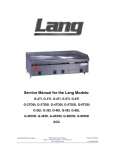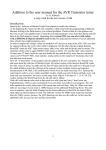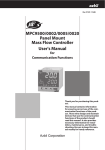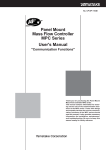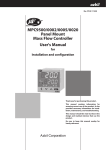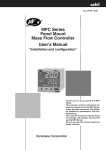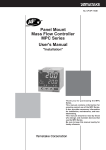Download Accu-Steam 2611 Service manual
Transcript
SERVICE MANUAL SERIAL NUMBERS 2611 AND UP NATURAL GAS AND PROPANE SP8016-1005 ACCU-STEAM SERVICE MANUAL Technical Services Toll Free Office Fax email Web Site SP8016-1005 800.480.0415 260.469.3040 260.493.8914 [email protected] www.accutemp.net ACCU-STEAM SERVICE MANUAL TABLE OF CONTENTS Table of contents 1 Document history 2 INTRODUCTION 3 SEQUENCE OF OPERATIONS 3 TROUBLESHOOTING MATRIX 4-5 REMOVAL AND INSTALLATION - TRANSFORMER 5 REMOVAL AND INSTALLATION - LAMPS 6 REMOVAL AND INSTALLATION - SWITCH 6 REMOVAL AND INSTALLATION - THERMOSTAT 7-8 REMOVAL AND INSTALLATION - TEMPERATURE SENSOR 8 REMOVAL AND INSTALLATION - TIME DELAY RELAY 9 REMOVAL AND INSTALLATION - HI LIMIT ASSEMBLY 9-10 REMOVAL AND INSTALLATION - STANDBY BURNER ( PILOT) 11 REMOVAL AND INSTALLATION - MAIN BURNERS 12 REMOVAL AND INSTALLATION - IGNITION MODULE 12 REMOVAL AND INSTALLATION - CONTROL AND MAIN VALVE AND PILOT REGULATOR 13 TESTING - FLAME SENSE 18-19 TESTING - CHAMBER INTEGRITY 19 CHART - RESISTANCE RTD TEMPERATURE SENSOR 20 CHART - RESISTANCE K TYPE TEMPERATURE SENSOR 20 CHART - ORIFICE SIZE VERSUS ELEVATION AND BTU CONTENT 21 Schematic - standard ignition 22 Schematic - intermittent ignition with main burner valve 23 Schematic - intermittent ignition 24 SP8016-1005 ACCU-STEAM SERVICE MANUAL PAGE 1 Document history Current revision 1005 SP8016-1005 Date 5/14/10 Prior revision Date N/A N/A Change Initial release of manual ACCU-STEAM SERVICE MANUAL PAGE 2 INTRODUCTION The griddle is constructed and uses technology like no other griddle in the world. The griddle cooking surface is the top of a chamber which has a unique environment. Welded stainless steel reinforcements studs connect the chamber top to a chamber bottom. The perimeter joints are all robotically welded and produce a vessel that is air tight. The chamber is filled half full with distilled water. The remaining air is removed and the chamber is welded shut. At this point, the chamber becomes a hermetically sealed vessel, never to be opened again. The griddle steam chamber requires no water or maintenance. A thermo-well for a thermocouple and a thermo-well for the overtemp safety shutdown system are also welded into the griddle steam chamber. At temperatures below 212°F (100 C), the chamber is actually in a vacuum, similar to that of a canning jar. At temperatures above 212 °F, the chamber operates under pressure. Located between the water and the bottom of the cooking surface is the best heat transfer medium – steam, the most effective way to transfer heat. The thermocouple senses the temperature of the steam and reports this data to the thermostat, which energizes the burners. This system maintains the griddle cooking surface temperatures to within ± 3 °F over the entire cooking surface and provides a near instant temperature recovery, even on the same spot on the griddle, when turning food in place. Intermittent Ignition SEQUENCE OF OPERATION S/N’s 7184 and UP Power comes in the back of the unit and goes to the transformer. The transformer lowers the voltage to 24 volts VAC. Power is then transferred to the high limit. When the circuit is energized there will always be power to the thermostat. When the thermostat calls for heat it will send power to the ignition module. Once the standby burner is lit and the module is satisfied power will then be transferred to the time delay relay. When the time delay relay times down, the main burners will ignite. When the heat cycle is over all burners will be off. Continuous Pilot Burner SEQUENCE OF OPERATION S/N 2611 to 7183 120V power is supplied to the primary side of the transformer. 24VAC comes off the secondary side of the transformer which provides power to the over-temp / solder washer assembly. Once the ON/ OFF switch is set to the ON position, power is applied to the ignition module through the blue wire and back out the red wire to the main gas control valve. The ignition module will send high voltage to the Ignitor probes thus causing a spark to ignite the standby burner. If the ignition module doesn’t sense a flame it drops power to the main gas control valve and will shut down the griddle. If the ignition module receives the acceptable level of flame sense the ignition cycle continues and the time delay relay times out and sends voltage to power to thermostat. The thermostat in conjunction with the temperature sensor regulate the heat as required. If at any time the ignition module flame sense voltage is not acceptable it cuts power to the griddle. SP8016-1005 ACCU-STEAM SERVICE MANUAL PAGE 3 TROUBLE SHOOTING MATRIX SYMPTOM Unit is cutting out and / or shutting down POSSIBLE CAUSE Ignition probe EVALUATION Check for oxidation. Clean probes if oxidized. Check for probes being loose in the ceramic. Make sure the ground probe is touching the ceramic part of the heating element and the other two probes should be the height of a nickel off the ceramic. Millivolt readings, using the recommended probe set, between the orange ignition wire and the green ground wire should read between 30 to 50 DC millivolts (.045 uA or higher) when the stand by burner is ignited. This can be measured at the ignition module. Replace if necessary. Flue Check for grease or food build up in the flue. Clean for proper air flow. Check that the flue has not been pushed in. Straighten if necessary. Check for a cracked or sunken ceramic. Replace if necessary. Check for a plugged orifice. Clean as necessary. Stand by (Pilot) burner Orifice Ignition module Gas pressure. Venturi tubes Ventilation Valves Unit will not start Hi-Limit over-temp Switches On and off contacts Gas supply Electric supply Transformer Ignition Cable Orifices Fuses SP8016-1005 Check for loose connections or misaligned pins in the Molex connector. Tighten or replace as necessary. Also check the ignitor cable. Main burners should be set at 5 and the stand by burner should be set at 3.5 inches of water column for natural gas when the griddle is in operation. For propane units the pilot should be set at 8 inches and the main burner should be set at 10 inches. Check to see if an external gas regulator is affecting the pressures. Gas pressures to be checked with the burners on. Check for any blockage and clean as necessary. Check for down drafts that might be blowing the pilot flame out. Check for loose connections or if they are sticking closed. Replace as necessary. Check to see if the solder washer is melted. Replace as necessary. See over-temping section. Check for continuity. Replace as necessary. Check for continuity. Replace as necessary. Check for gas supply to the unit and that the gas valve is open. Check that power is supplied to the unit. Check the ground fault receptacle if used. Check for line voltage to the primary side and that 24 volts is present at the secondary side. Replace as necessary. Check for cracks or loose connections. Check for any blockage and clean as necessary. Check for continuity. Replace as necessary. ACCU-STEAM SERVICE MANUAL PAGE 4 TROUBLE SHOOTING MATRIX SYMPTOM Unit is over / under temp POSSIBLE CAUSE Thermostat Thermocouple EVALUATION This is a type K thermostat. Check that 24 volts AC is present at terminals 4 & 5. For units with serial numbers 7551 and up, the thermostat will be a RTD type. This is a type K thermocouple (red and yellow leads). Refer to the thermocouple chart for proper measurements. For units with serial numbers 7551 and up, this will be a RTD probe. (two red leads) Must use the correct probe with the type of thermostat installed. Make sure that the unit is level. Perform the 9 point temperature test and correspond with the temperature setting. (three reading across the back, three across the middle and three across the front. All readings should be within 3 degrees. Check for hot spots or leaks. Notify Accutemp Service with any fluctuating readings. Uneven temperatures Unit installation Unit is blowing flames out of the back Flue Clean the flue of any obstructions or build up. Burners Check for damaged ceramics. Replace as necessary Gas pressure. Maximum supply gas pressure should not exceed 0.5 psig. (14” WC) External regulators should not be used unless this reading is exceeded. REMOVAL AND INSTALLATION TRANSFORMER 1. Unplug the unit 2. Remove the three screws from the front door panel and drop the panel down. 3. Disconnect the wires from the primary and secondary side of the thermostat. Note their locations. 4. Remove the nylock nuts and pull the transformer out. 5. Reassemble in reverse order. Transformer at0e-1809-1 SP8016-1005 ACCU-STEAM SERVICE MANUAL PAGE 5 REMOVAL AND INSTALLATION LAMPS The lamps are a neon style lamp that is driven by 24vac. 1. Unplug the unit. 2. Remove the three screws from the front door panel and drop the panel down. 3. Remove the wires from the lamps. 4. Depress the locking ears on the lamp with a pair of pliers and push thru the front of the panel 5. Reinstall in reverse order. POWER at0e-1800-2 HEAT at0e-1800-1 ON / OFF SWITCH AND CONTACTS This switch consists of 4 parts and each can be changed individually if any of the parts failed. 1. Unplug the unit. 2. Remove the three screws from the front door panel and drop the panel down. 3. Remove the wires from the contacts and note their location. 4. Push the spring loaded locking tab on the mounting ring and pull the switch out from the front of the panel. 5. Pry the contacts off of the locking ring. 6. Reinstall in reverse order. Switch, selector AT0E-3336-1 SP8016-1005 Mounting block AT0E-3339-1 ACCU-STEAM SERVICE MANUAL CONTACT, ON AT0E-3338-1 2 REQUIRED PAGE 6 REMOVAL AND INSTALLATION THERMOSTAT WARNING - ALL THERMOSTATS MUST BE CALIBRATED TO 400 °F, ( +1 °F,/-4 °F,) 1. Unplug the unit 2. Remove the three screws from the front door panel and drop the panel down. 3. Remove the knob and retaining nut from the front of the panel. 4. Disconnect the wires from the pins on the thermostat. Note their locations. 5. Reassemble in reverse order. Note: Units with serial numbers 2611 to 7550 have a type K thermostat and thermocouple. (red and yellow leads) Serial numbers 7551 and above have a RTD thermostat and probe. (two red leads). When replacing a thermostat, always use a RTD thermostat and probe. K Type Temperature Controller - P/N AT0E-2559-3 This was replaced by the RTD Controller P/N AT0E-2559-6 & Thermocouple P/N AT0E-2885-3 Must be used on all older series griddles with the welded in thermocouple Calibration Pot RTD Type Temperature Controller - P/N AT0E-2559-6 Must use RTD Thermocouple P/N AT0E-2885-3 Calibration Pot SP8016-1005 ACCU-STEAM SERVICE MANUAL PAGE 7 REMOVAL AND INSTALLATION RTD THERMOSTAT CALIBRATION The operating temperature range is 200 °F to 400 degrees F. Record the measured griddle surface temperature at the set points of 200 °F, 300 °F and 400 °F to determine if the controller is out of range. The calibration offset potentiometer shifts the range up or down but range or gain width is fixed and cannot be adjusted. If the controller is ± 10 °F out of range, replace it. 1. Open the control panel 2. Plug the unit in and hook up the gas supply. 3. Place a weighted temperature probe on the cooking surface of the griddle in a location above the griddle temperature sensor. Keep the probe off of the dimples and use a small amount of high temperature cooking oil between the surface of the probe and giddle. 4. Set the thermostat at 200 °F, turn the unit on and allow the temperature to stabilize. Take a reading from the thermometer and record the value. 5. Set the thermostat at 300 °F, allow to stabilize and record the value. 6. Set the thermostat at 400 °F, allow to stabilize and record the value. 7. Take a reading from the thermometer. The value should be 400 °F (+1 °F / -4 °F).If not, adjust the offset potentiometer on the thermostat and allow the unit to stabilize. 8. Repeat step 7 as is necessary. 9. Close the control panel, install the retaining screws and allow the unit to stabilize. 10. Observe the thermometer. The indicator reading should be 400 degrees F (+1 °F / -4 °F). If the reading is not, open the panel and repeat steps 7 – 9. TEMP PROBE The temperature sensor is screwed into a thermal-well underneath the griddle chamber. It is isolated from the distilled water of the griddle chamber. It is designed to indicate temperature by changing the resistance based on temperature to the thermostat. Be careful if you have to drill out the sensor not to puncture the chamber as it will render the griddle un-repairable. 1. Unplug the unit. 2. Remove the three screws from the front door panel and drop the panel down. 3. On the bottom side of the unit, locate the thermal-well that the probe capillary is screwed into and remove. 4. Remove the leads from pins 6 & 7 on the thermostat. 5. Reinstall in reverse order. (Type K probe, yellow on #6 and red on #7) Probe location underside of griddle SP8016-1005 rtd Temperature sensor AT0e-2885-3 ACCU-STEAM SERVICE MANUAL PAGE 8 REMOVAL AND INSTALLATION TIME DELAY RELAY The time delay relay is used to delay a signal to allow for the proper mixture of air and gas before igniting the main burners. 1. Unplug the unit 2. Remove the three screws from the front door panel and drop the panel down. 3. Remove the mounting screw in the middle of the relay and the two wires. 4. Reinstall in reverse order. Note: Make sure the adjustment pot is set for 20 seconds. Time delay adjustment set for 20 seconds Relay, time delay at2h-2500 HI-LIMIT ASSEMBLY Is a safety designed to turn off the griddle at a preset temperature to limit the pressure of the steam chamber so that it doesn’t set off the one time pressure relief valve which will render the griddle un-repairable 1. Unplug the unit. 2. Remove the Hi-Limit access cover located under the griddle. Verify the Hi Limit rod has pulled and released the switch before proceeding. 3. Remove the switch bracket and assembly by first removing the two nuts. Be careful not to lose any of the parts located underneath. Note: The entire assembly will want to drop down when removing the bracket. 4. Replace the rod, solder washer, flat washer and the spring. Put the two washers on the studs and reattach the switch bracket Note: It is extremely important that the solder washer has good surface contact with the surface of the thermal-well. Make sure the solder washer is installed before the flat washer. 5. Reattach the spring and access cover. See the drawing on the following page. Solder washer At2m-2860-1 Washer at2f-1367-1 Rod at2m-2861-1 Microswitch at2e-1639-1 SP8016-1005 Extension spring at2h-1640-1 Compression Spring at2h-1365-1 Bracket, switch at2m-1558 Microswitch cover at2e-1759 ACCU-STEAM SERVICE MANUAL PAGE 9 REMOVAL AND INSTALLATION SP8016-1005 ACCU-STEAM SERVICE MANUAL PAGE 10 REMOVAL AND INSTALLATION STANDBY BURNER (PILOT BURNER) This device is a small ceramic burned used to ignite the main burners. It also has the ignition probe and flame sense probe. Improper installation can cause the griddle not ignite or intermittently shutdown 1. Unplug the unit and shut off the gas supply and let the unit cool. 2. Loosen the hose clamp on the venturi. 3. Loosen the two nuts that hold the burner spacer and step bracket. 4. Remove the two nuts on the studs that hold the ignitor sensor bracket. 5. Remove the ignitor cable from the ignitor probe. Inspect for damage. 6. Pull the orifice adaptor out of the venturi and pull the pilot assembly down. Note: Check the ignitor probes and ground plane assembly for discoloration or oxidation and replace as needed. Also check for proper gapping. See illustration below. 7. Remove the orifice adaptor from the compression elbow and clean. 8. Reinstall in reverse order. Note: Make sure that the hose clamp does not block the venturi opening. See Pages XX to XX for instructions on measuring flame sense. PROBES IGNITOR & FLAMES SENSE SETTING STANDBY BURNER AT2A-2255-2 SP8016-1005 Ignitor kit ACCU-STEAM SERVICE MANUAL PAGE 11 REMOVAL MAIN BURNERS AND INSTALLATION Main burners are a ceramic burner that supplies the required heat to operate the griddle. If the get wet they should be allowed to dry without applying heat as they will crack and will need replaced 1. Unplug the unit and disconnect the gas and let the unit cool. 2. Remove the retaining nut from the gas supply elbow. 3. Remove the four retaining nuts from burner box flange and drop the box down. 4. Clean the orifices. 5. Reassemble in reverse order and run the unit up to 400 degrees. Burner 24” Model at2b-2131-1 36”& 48” Model Burner at2b-2991-1 IGNITION MODULE Is the electronic device that verifies that the griddle has ignited and is running. If the proper signals are not received from the flame sense it will lockout the griddle. 1. Unplug the unit. 2. Remove the three screws from the front door panel and drop the panel down. 3. Disconnect the ignition cable, molex connector for the wire harness and the mounting screws. Apply silicone dielectric grease to the connections. 4. Reassemble in reverse order. Note: Serial numbers 7184 and above will have an Interim Intermittent Ignition system in conjunction with the dual solenoid valve. The main gas valve was removed Ignition module at2e-1807-1 SP8016-1005 ACCU-STEAM SERVICE MANUAL PAGE 12 REMOVAL AND INSTALLATION GAS CONTROL VALVE, MAIN BURNER VALVE AND PRESSURE REGULATOR 1. Unplug the unit and disconnect the gas. 2. Remove the three screws from the front door panel and drop the panel down. 3. Disconnect the union on the left hand side and the fitting on the right hand side of the flex hose. 4. Pull the valves out and replace the defective part. 5. Reassemble in reverse order. OLD STYLE VALVE TRAIN S/N 2661 TO 7894 NEW STYLE VALVE TRAIN S/N 7895 & UP Pressure Adjustment Remove Dust Cap to adjust 1/4 NPT 1/8 NPT Control Valve and Pilot Valve gas pressures must be adjusted after replacing to assure to assist in correct operation. GAS PRESSURE CHART GAS TYPE NATURAL PROPANE MAIN PRESSURE 5 INCHES WATER COLUMN 10 INCHES WATER COLUMN Control Valve AT2E-1806-2 - NG (5”wc) AT2E-1806-3 - P (10”wc) SP8016-1005 PILOT PRESSURE 3.5 INCHES WATER COLUMN 8 INCHES WATER COLUMN Main Burner Valve at2e-2087-1 S/N 7894 & Lower ACCU-STEAM SERVICE MANUAL Pilot Valve At0p-2847-1- NG (3.5”WC) AT0P-2847-2 - P (8” WC) PAGE 13 TESTING Flame Sense Measurement The ACCU-STEAM gas griddle has a flame sensing circuit to determine if the system has proper combustion. When the system is turned on gas is sent to the pilot burner and an electronic ignition tries to ignite the griddle. The griddle then checks to see if flame is established in the pilot burner. If the flame sense feedback voltage is within the proper range the system will ignite the main burners and they stay on until the thermostat is satisfied. The griddle flame sense continues to monitor the voltage and as long as it within the proper range the griddle will stay on. If the flame sense voltage falls below the threshold the griddle will go into lock out and will shut down the griddle. Cycling the on/off switch will restart the ignition and flame sense test. If it fails again you may need to troubleshoot the ignition/flame sense section. TROUBLESHOOTING How to make a diagnosis: 1. Determine that power is present at the griddle 2. Determine that gas is supplied at the proper pressures to the unit. 3. Install an inch-units H2O manometer onto the port on the side of the main gas regulator valve and onto the pressure tap outboard of the pilot regulator. 4. Install a flame-sensing probe into the flame sense circuit. a. A meter with micro amp (<A) selection or a micro amp adapter must be place in series with the orange flame sense wire. To check micro amps, disconnect the orange wire from the flame rod, connect the amp meter in series with the flame sensing rod terminal and the orange wire from the wiring harness. b. An Accutemp volt-measuring adapter P/N FT0003 (meter set for millivolts) is placed in parallel with the orange flame sense circuit. Attach one end of the adapter to the orange wire and the other to ground. 5. Turn the unit on (Power lamp is lit) 6. If the pilot burner is not lighting and there is no spark, check for 24 VAC input to the ignition module. a. If there is 24VAC present at the ignition module and all of the ground connections are good, check the ignition cable for an open or a short to ground. b. If there is 24VAC present at the ignition module and all of the ground connections and the ignition cable are good, test for spark by disabling the main regulator gas valve and place the ignitor cable close to ground. Turn the griddle ON. If there is no spark, replace the ignition module. c. If there is a spark, check the ignitor probe spark gap on the pilot burner. Adjust, if necessary. If the probes look badly oxidized, replace the probes. 7. If there is spark but no gas to the pilot regulator, check for 24VAC at the gas valve coil. If 24VAC is not present at the coil of the main regulator gas valve, and the connecting harnesses are good, replace the ignition module. 8. If 24VAC is present at the gas valve coil and no gas is flowing to the pilot regulator, replace the main regulator gas valve. When changing the valve, check for debris in the gas line and valve. Ensure that a drip leg is installed before the unit. regulator. SP8016-1005 ACCU-STEAM SERVICE MANUAL PAGE 14 TESTing 9. If the pilot burner is lighting, determine if the sensing signal level is 25mV (1.07uA) or higher (see the attached millivolt to micro amp chart). a. If the level is less than 25mV (1.07uA), check for proper gas pressures to the main regulator and to the pilot regulator. For natural gas, the pressures must be 5" H2O for the main gas valve and 3.5" H2O for the pilot burner regulator. For propane gas, the pressures must be 10" H2O for the main gas valve and 8.0" H2O for the pilot burner regulator. b. If the gas pressures are good but the sensing signal level is still poor, check the pilot orifice for obstruction. Clean or replace as necessary. c. If the gas pressures are good, the pilot orifice is clean, the burner surface is glowing orange to bright orange but the signal level is still poor, replace the ignitor probe set and ground plane. 10. Four types of meter readings are possible: 0 millivolts or 0 micro amps; a steady reading of 25 millivolts or 1.07 micro amps or more; a low reading less than 25 millivolts or 1.07 microamps; or a fluctuating reading that won’t stabilize. The possible causes for each type of reading are: a. 0 millivolts or micro amps – Look for an open or grounded sensor wire or flame rod, or a defective ignition module. The wire and rod can be diagnosed with an ohmmeter. Make the diagnosis of a defective ignition module after all other possibilities have been exhausted. b. 25 millivolts or 1.07 micro amps, with a steady reading – The system is operating within normal parameters. c. Fluctuating meter reading – Check that the flame sensor probes are properly located. Also check for drafts that can cause an unstable flame. A dirty orifice can also cause an unstable flame. d. Less than 25 millivolts or 1.07 micro amps – Look for a pilot flame that’s not properly engulfing the flame-sensing rod. A flame sensor probe too close to the tile will not be in the proper part of the flame, with not enough ionized gas to allow a proper signal level to be conducted. Conversely, the same thing holds true if the flame sensor is too high. Also check the ground connection back to the ignition module. Check that the flame-sensing rod and ground plane are not oxidized. Clean both with a non aluminum oxide abrasive. Important! The ignition module should be the last item that is replaced. Ignition modules are designed and tested to rigorous standards to ensure safe and consistent operation. Therefore, focus on other less robust components before swapping out the ignition module. Flame Sense Measurement Using the voltage method 1. Connect Flame Tester, AccuTemp P/N FT- 003 to your multimeter 2. Set multi-meter to DC mv. 3. Connect Flame Tester leads, to Igniter Harness Orange (or Yellow) and Green wires. 4. Verify your reading is above 60 DC mv and the system will shutdown below 19 DC mv. SP8016-1005 ACCU-STEAM SERVICE MANUAL PAGE 15 TESTing CHAMBER INTEGRITY TEST Tools Required: • Level • Calibrated Digital Temperature Meter (Such as the Cooper - Atkins EconoTemp • Weighted Temperature Probe - ( Such as Cooper/Atkins) DIgital Temperature Meter & Weighted Temperature Probe Due to the patented design of our griddle it is imperative that the chamber has no leaks as this allows water to escape and air to move in causing inconsistent temperatures on the cooking surface. This test will determine if the cooking chamber is functioning properly. Notes: Do not use a infrared temperature measuring device as it will not work correctly. 1. Verify griddle is level front to back and side to side before attempting this procedure. 2. With the griddle plugged in, set thermostat dial to 200ºF and turn on. If this is a internal thermostat model you will need to open the control panel to set the thermostat. 3. Place the weighted temperature probe in the center in the first 1/3 of the griddle cooking surface on a 4. 5. 6. 7. small amount of high temperature cooking oil. Make sure that the probe is between the griddle weld stud dimples to assure a proper reading. Allow the griddle to heat to the initial temperature setting. Increase thermostat setting to 300ºF allow griddle to cycle through two heat cycles. Place weighted temperature probe and record temperatures according to the chart below Temperatures shall be within ±5º F of each other across the entire surface. SP8016-1005 ACCU-STEAM SERVICE MANUAL PAGE 16 Temperature sensor (thermocouple) resistance chart RTD TEMPERATURE SENSOR AT0E-2885-3 RTD PROBE °F 0 100 200 300 400 RTD Resistance Value 1000Ω 1146Ω 1359Ω 1569Ω 1775Ω K TYPE TEMPERATURE SENSOR AT0E-2885-2 TYPE K THERMOCOUPLE READINGS - THERMOELECTRIC VOLTAGE IN DC MILLIVOLTS F° 70 80 90 100 110 120 130 140 150 160 170 180 190 200 210 220 230 240 250 260 270 280 290 300 310 320 330 340 350 SP8016-1005 0 0.843 1.068 1.294 1.521 1.749 1.977 2.207 2.436 2.667 2.897 3.128 3.359 3.59 3.82 4.05 4.28 4.509 4.738 4.965 5.192 5.419 5.644 5.869 6.094 6.317 6.54 6.763 6.985 7.207 1 0.865 1.09 1.316 1.543 1.771 2 2.23 2.459 2.69 2.92 3.151 3.382 3.613 3.843 4.073 4.303 4.532 4.76 4.988 5.215 5.441 5.667 5.892 6.116 6.339 6.562 6.785 7.007 7.229 2 0.888 1.113 1.339 1.566 1.794 2.023 2.253 2.483 2.713 2.944 3.174 3.405 3.636 3.866 4.096 4.326 4.555 4.783 5.011 5.238 5.464 5.69 5.914 6.138 6.362 6.585 6.807 7.029 7.251 3 0.91 1.136 1.362 1.589 1.817 2.046 2.276 2.506 2.736 2.967 3.197 3.428 3.659 3.889 4.119 4.349 4.578 4.806 5.034 5.26 5.487 5.712 5.937 6.161 6.384 6.607 6.829 7.052 7.276 4 0.933 1.158 1.384 1.612 1.84 2.069 2.298 2.529 2.759 2.99 3.22 3.451 3.682 3.912 4.142 4.372 4.601 4.829 5.056 5.283 5.509 5.735 5.959 6.183 6.406 6.629 6.852 7.074 7.296 5 0.955 1.181 1.407 1.635 1.863 2.092 2.321 2.552 2.782 3.013 3.244 3.474 3.705 3.935 4.165 4.395 4.623 4.852 5.079 5.306 5.532 5.757 5.982 6.205 6.429 6.652 6.874 7096 7.318 6 0.978 1.203 1.43 1.657 1.886 2.115 2.344 2.575 2.805 3.036 3.267 3.497 3.728 3.958 4.188 4.417 4.646 4.874 5.102 5.328 5.554 5.779 6.004 6.228 6.451 6.674 6.896 7.118 7.34 ACCU-STEAM SERVICE MANUAL 7 1 1.226 1.453 1.68 1.909 2.138 2.367 2.598 2.828 3.059 3.29 3.52 3.751 3.981 4.211 4.44 4.669 4.897 5.124 5.351 5.577 5.802 6.026 6.25 6.473 6.696 6.918 7.14 7.362 8 1.023 1.249 1.475 1.703 1.931 2.161 2.39 2.621 2.851 3.082 3.313 3.544 3.774 4.004 4.234 4.463 4.692 4.92 5.147 5.374 5.599 5.824 6.049 6.272 6.496 6.718 6.941 7.163 7.384 9 1.045 1.271 1.498 1.726 1.954 2.184 2.413 2.644 2.874 3.105 3.336 3.567 3.797 4.027 4.257 4.486 4.715 4.943 5.17 5.396 5.622 5.847 6.071 6.295 6.518 6.741 6.963 7.185 7.407 10 1.068 1.294 1.521 1.749 1.977 2.207 2.436 2.667 2.897 3.128 3.359 3.59 3.82 4.05 4.28 4.509 4.738 4.965 5.192 5.419 5.644 5.869 6.094 6.317 6.54 6.763 6.985 7.207 7.429 PAGE 17 GAS GRIDDLE ORIFICE Reference CHART FOR altitude and btu content GAS GRIDDLE ORIFICE REFERENCE TABLE FOR ALTITUDE AND BTU CONTENT NOTE: This Table represents the standard upper and lower ranges of BTU per cubic foot content. There is no relationship between the natural gas BTU content and the propane BTU content as shown in each section of this Table. HEAT VALUE BTU/CU FT. (NATURAL GAS - 990, PROPANE GAS - 2200) 24" GRIDDLE MAIN 36" GRIDDLE 48" GRIDDLE PILOT BURNER BURNER MAIN BURNER MAIN BURNER Altitude ft NG LP NG LP NG LP NG LP 3000 #59 #71 #49 #56 #40 #54 #40 #53 4000 #59 #71 #50 #57 #43 #53 #44 #53 5000 #59 #72 #50 #57 #44 #54 #45 #54 6000 #60 #73 #51 #58 #44 #54 #46 #54 7000 #61 #73 #51 #58 #45 #54 #47 #54 8000 #61 #74 #52 #58 #46 #54 #47 #55 9000 #62 #74 #53 #58 #47 #56 #49 #56 10000 #64 #74 #53 #59 #48 #56 #50 #56 HEAT VALUE Altitude ft 3000 4000 5000 6000 7000 8000 9000 10000 HEAT VALUE Altitude ft 3000 4000 5000 6000 7000 8000 9000 10000 SP8016-1005 NATURAL GAS - 1000 24" GRIDDLE MAIN PILOT BURNER BURNER NG LP NG LP #59 #71 #49 #57 #59 #71 #50 #58 #60 #72 #51 #58 #61 #73 #52 #58 #62 #73 #53 #58 #63 #74 #54 #59 #64 #74 #55 #59 #65 #74 1.25MM #60 PROPANE GAS - 2300 36" GRIDDLE MAIN 48" GRIDDLE MAIN BURNER BURNER NG LP NG LP #42 #54 #43 #55 #42 #54 #43 #55 #45 #54 #44 #56 #45 #55 #44 #56 #46 #55 #45 #56 #46 #55 #45 #56 #47 #55 #47 #57 #48 1.25MM #48 #58 NATURAL GAS - 1100 24" GRIDDLE MAIN PILOT BURNER BURNER NG LP NG LP #59 #71 #50 3/64 #60 #71 #51 #57 #61 #72 #52 #57 #62 #73 #52 #57 #63 #73 #53 #57 #64 #74 #54 #58 #65 #74 #54 #59 #65 #74 #54 #59 PROPANE GAS - 2400 36" GRIDDLE MAIN 48" GRIDDLE MAIN BURNER BURNER NG LP NG LP #43 #54 #42 #55 #43 #54 #44 #55 #44 #55 #45 #55 #44 #55 #45 #55 #46 #55 #46 1.25MM #47 #55 #47 1.25MM #48 1.25MM #48 3/64 #49 1.25MM #49 3/64 ACCU-STEAM SERVICE MANUAL PAGE 18 GAS GRIDDLE ORIFICE Reference CHART FOR altitude and btu content HEAT VALUE NATURAL GAS - 1200 24" GRIDDLE MAIN PILOT BURNER BURNER Altitude ft NG LP NG LP 3000 #60 #71 #51 3/64 4000 #61 #71 #51 #57 5000 #63 #72 #52 #57 6000 #63 #72 #52 #57 7000 #64 #72 #53 #57 8000 #65 #72 #54 #58 9000 #65 #72 #54 #59 10000 #66 #72 #54 #59 PROPANE GAS - 2500 36" GRIDDLE MAIN 48" GRIDDLE MAIN BURNER BURNER NG LP NG LP #43 #54 #42 #55 #43 #54 #44 #55 #44 #55 #45 #55 #44 #55 #45 #55 #46 #55 #46 1.25MM #47 #55 #47 1.25MM #48 1.25MM #48 3/64 #49 1.25MM #49 3/64 HEAT VALUE PROPANE GAS - 2700 36" GRIDDLE MAIN 48" GRIDDLE MAIN BURNER BURNER NG LP NG LP #46 #53 #45 #54 #46 #54 #47 #54 #47 #54 #48 #55 #48 #54 #48 #55 #49 #55 #49 #56 #50 #55 #50 #56 #51 1.25MM #50 #56 #52 1.25MM #51 #57 NATURAL GAS - 1300 24" GRIDDLE MAIN PILOT BURNER BURNER Altitude ft NG LP NG LP 3000 #60 #71 #52 #56 4000 #62 #72 #52 #56 5000 #63 #73 #53 #56 6000 #64 #73 #54 #58 7000 #64 #74 #55 #58 8000 #65 #74 #55 #59 9000 #66 #74 #55 #60 10000 #68 #75 #56 #62 SP8016-1005 ACCU-STEAM SERVICE MANUAL PAGE 19 SCHEMATICS AT2T-3041-1 STANDARD IGNITION SERIAL NUMBERS 2661 TO 7184 BLK 24V SEC BLK 120V PRI. WHT BLU YEL WHT N.C. OFF N.O . RED SW2 O. T. SW 1 P1 2 1 J1 2 VIO RED MAIN GAS CONTROL VALVE RED VIO 1 2 PWR NA 3 K TYPE CONTROLLER COM 4 6 + VIO RED DELAY TIMER RED WHT PWR LT1 RED MAIN BURNER VALVE ORN YEL K TYPE 7 - 2 5 OUTPUT BLU to CAL OFFSET ADJ 1 BLU RED BLK RED ON GRN ORN or YEL GRN 3 4 5 RED HEAT LT2 SENSOR 6 BURNER SPARK MODULE HV IGNITOR AT2T-3041-1 AT2T-3041 SP8016-1005 ACCU-STEAM SERVICE MANUAL PAGE 20 SCHEMATICS AT2T-3041-3 INTERMITTENT IGNITION WITH MAIN BURNER VALVE SERIAL NUMBERS 7185 TO 7894 BLK BLK 120V PRI. 24V SEC WHT BLU YEL WHT N.C. OFF N. O. RED P1 2 1 J1 2 YEL VIO RED SW2 O.T. SW 1 ON RED BLK MAIN GAS CONTROL VALVE VIO 1 PRTD TYPE CONTROLLER RED L1 YEL PWR LT1 3 L2 5 6 OUTPUT to 8 CAL OFFSET ADJ 9 BLU 1 2 3 5 MAIN BURNER VALVE ORN DELAY TIMER RED RED ORN or YEL GRN 4 YEL PRTD PRTD GRN RED WHT HEAT LT 2 SENSOR 6 BURNER SPARK MODULE HV IGNITOR AT2T-3041 -3 SP8016-1005 ACCU-STEAM SERVICE MANUAL PAGE 21 SCHEMATICS AT2T-3041-2 INTERMITTENT IGNITION SERIAL NUMBERS 7895 & UP BLK BLK 120V PRI. 24V SEC WHT BLU YEL WHT N. C. OFF N.O. RED P1 2 1 J1 2 VIO MAIN GAS CONTROL VALVE RED SW2 O.T. SW 1 ON RED MAIN BURNER VALVE RED BLK VIO ORN RED DELAY TIMER 1 L1 PRTD TYPE CONTROLLER YEL HEAT LT 2 3 L2 5 6 OUTPUT o t 1 2 3 4 5 PWR LT 1 RED RED ORN or YEL GRN BLU YEL PRTD 8 9 - PRTD - CAL OFFSET ADJ GRN RED WHT SENSOR 6 BURNER SPARK MODULE HV IGNITOR AT2T-3041 -2 SP8016-1005 ACCU-STEAM SERVICE MANUAL PAGE 22 SP8016-1005 ACCU-STEAM SERVICE MANUAL

























